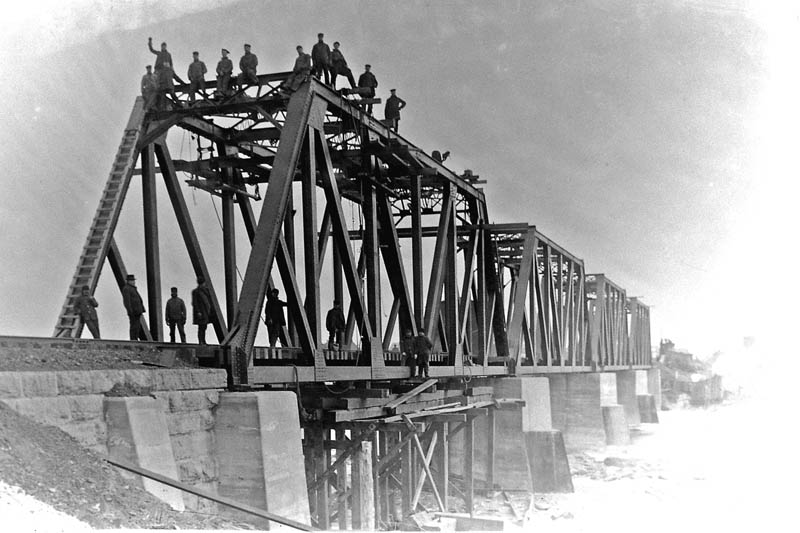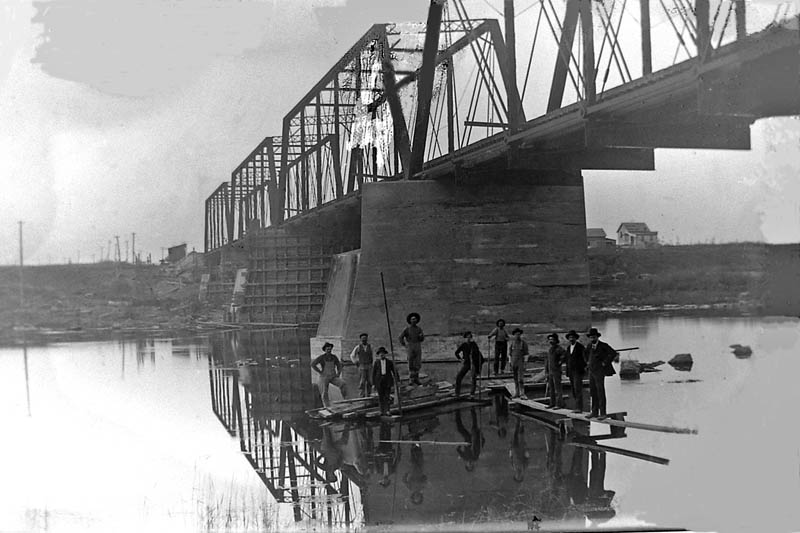The South Nation River, at mile 47.7 on the Alexandria subdivision
near Casselman, presented quite an obstacle to the builders of the
Canada Atlantic Railway and regular trains started running on 1st February 1882 from Coteau only as far as Casselman. Work went ahead vigorously to complete the line to Ottawa and the Ottawa Citizen of 23rd February 1882 reported:
“Between Ottawa and Casselman some 350 men were busily engaged on the work of construction. The masonry of the bridge over the Nation River was completed and the Toronto Bridge Company were at present proceeding with operations to allow them to go on with their part of the work. The
masonry of the bridge which was laid in cement, was done by Mr.
Linsley, contractor, and is in every respect a first class job. The
work was assiduously prosecuted during the winter and in order to
permit of this, artificial heaters were used upon which the stone was
laid preparatory to being placed upon the wall, The
bridge was some 350 feet in length and 30 feet high, and addition to
presenting a picture of stability the work was neatly executed....
“The
present time table issued by the company shows that there are two
passenger and two freight trains running daily between Coteau and
Casselman.”
Trains were running through to Limoges (then known as South Indian) by May 1882, and the line was opened through to Ottawa on September 13th the same year.
 This shows the bridge over the South Nation River just after it was completed in May 1882. It is typical for bridges of that period although not strong enough for today’s trains. Note
the Toronto Bridge Company Builders plate at the entrance. This was
normal practice and added a finishing touch to the Company’s elegant
structures. Unfortunately
in urban areas these quickly proved a tempting target for little boys
with stones although this one, in a rural setting, may have lasted
longer.
The country in this area was heavily wooded and much income was derived from lumber. Fires were an ever present threat and caused great destruction. On 16th June 1891 the Ottawa Journal reported: “Fire at Casselman. Special train sent out at 11 p.m. Arduous task of mounting the Conqueror, which taxed all muscles to the utmost. -- The engine and special relief train was driven by Engineer Macdonald, Fireman Kane and Brakeman Keswick. Away sped the train with 30 miles to go with 1,200 feet of hose and 1,000 feet of the C.A.R. hose. At
Eastman's, South Indian and Bearbrook the train took up hands till
there were 200 buckets and some 420 men on board. At 11.45 they left
Bearbrook and at 11.50 they steamed into Casselman.” The “Conqueror” was a horse-drawn fire pump, presumably steam powered. 1897 was a bad one for fires in the area. Fire-fighting equipment was again sent to Casselman by train on 5th October. Disaster struck the next day when the station and water tank at Casselman were destroyed. The bridge stringers were nearly all burned off and the bridge was rendered unsafe. A special gang of men at Booth's mill (in Ottawa) were set to work to cut timbers and a gang of 100 men were rushed to the site to put the bridge into shape for traffic. Mr. M. Donaldson, mechanical foreman, had a special wrecking train sent down during the morning with new timbers for the bridge. Men were at work all day on the bridge, and it was passable the same evening. A bizarre result of this fire was that the railway ran an excursion train from Ottawa for the curious (or morbid) to see the damage from the fire. The Ottawa Journal of 11thOctober 1897 mentioned:
“The C.A.R. excursion to South Indian and Casselman yesterday carried down 855 persons from Ottawa -- sightseers and relic hunters.”
The same day, the Ottawa Free Press said:“The train didn't remain at the station at North Casselman but proceeded over the bridge over the Nation river to South Casselman,
where the fire did the greatest destruction. The entire members
disembarked here and in a short time the streets and ruins were overrun
by curiosity and relic hunters.-- “It seems that the proceeds of the excursion went to relief of suffering.” After this brief period of excitement it seems the bridge settled down to a more peaceful existence. The Grand Trunk Railway, which took over the Canada Atlantic Railway, reconstructed the superstructure in 1905.
The plans were approved by the Board of Railway Commissioners order No. 437 of 1 May 1905
The
CAR (sic) was authorized to reconstruct the superstructure of the
bridge by Board order No. 492 of 6 June 1905,plan ref No. 16788.
The work was approved by Board order No. 529 of 4 July 1905, plan No. 16998.
These three pictures, courtesy of Pierre Grenon, show the bridge under reconstruction for the Grand Trunk Railway

This shows the original piers projecting from the later ones

This shows the original bridge with the taller piers under construction

This shows one of the spans rebuilt with the others still in original condition
Some
additional work was carried out in 1914 and the Grand Trunk was
authorized to operate over the structure by Board order No. 21525 of
20 March 1914.
The rear end collision on the bridge on 21 December 1944

No. 6218 in a rear end collision with another freight train Extra 2609 East This picture was taken from the east side of the river and the train is traveling towards Coteau. The
locomotive is Canadian National No. 6218, which later became well known
as an excursion locomotive after the end of regular steam. There were
no injuries or deaths in this accident which is a surprise as the
caboose of the train that was rear-ended has been completely destroyed. Note the two cattle cars right behind No. 6218. Cattle
cars were easily identified by the whitewash that was applied to the
lower portion of the car – it hid the signs and smell of the cattle. The cattle must have had a rough shunt!
The newspaper accounts of this wreck, which do not add a great deal, can be found at https://churcher.crcml.org/circle/Wreck%20Details/1944Casselman.html
However, Carl Riff has provided a copy of the statement from engineer Findley of No. 6218. This
gives a good account of winter railroading at a time when there were no
roller bearing axleboxes, before Walkley yard and before the
installation of Centralized Traffic Control (CTC): “Our train was ordered at Ottawa for 12:45 P.M. I reported for duty at 12noon. Engine was off the shop track on time. Engine was moved to Bank St. for train, and we left the yard at 1:23 P.M. and passed the outer switch, located just east of Bank St. yard office at 1:50 P.M. Account train being frozen up we were assisted out of yard by yard engine as far as Main St. At Bank St. I received a terminal clearance and running order, and at Riverside a terminal clearance along with a form “W”. The order at Riverside was delivered on a hoop and our train passed Riverside No
additional train orders were delivered, we proceeded at a speed of
about 25 M.P.H. – the train having been frozen up in the yard, was
pulling hard. I had planned going to Alexandria for
water, and when about one mile west of Casselman and running at a speed
of 37 or 38 M.P.H. I made a service application of the brakes in order
to bring the train under control rounding the curve, and to permit a
good view of the train order signal. There
is a down grade towards the bridge. Immediately I made the service
application of the brake I heard the sound of two torpedoes exploding
and saw Flagman about 3 poles east of where the torpedoes exploded. The Flagman had a red flag and was giving me a stop signal. The flagman was located 7 poles west of the bridge and standing on a farm crossing. Immediately
the torpedoes exploded and I saw the Flagman, I threw my brake valve
into emergency and train slowed down to a point where I thought my
train would stop before reaching caboose, which I saw when my engine
was about west end of the bridge. My train was not moving more than 5
M.P.H. at time of impact, but it seemed to me the weight of the train
kept shoving ahead.” about 1:40 P.M. The Grand Trunk rebuild is essentially the bridge we know today except that modifications were
carried out in the early 1990s to allow double stack container trains
to pass through. |


